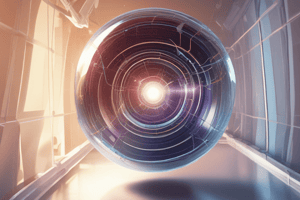Podcast
Questions and Answers
If a neural network trained on a specific dataset is subsequently used to make predictions on entirely new, unseen data, which of the following is MOST crucial for ensuring the reliability of its predictions?
If a neural network trained on a specific dataset is subsequently used to make predictions on entirely new, unseen data, which of the following is MOST crucial for ensuring the reliability of its predictions?
- Maximizing the model's complexity to capture all nuances in the training data.
- The diversity and representativeness of the training dataset. (correct)
- The specific programming language used to implement the neural network.
- The number of layers in the neural network.
In the context of neural networks, what is the PRIMARY role of an activation function?
In the context of neural networks, what is the PRIMARY role of an activation function?
- To normalize the input data.
- To prevent overfitting by simplifying the model.
- To introduce non-linearity into the network. (correct)
- To reduce the dimensionality of the input.
During the training of a neural network, you observe that the training loss is decreasing, but the validation loss starts increasing. What does this MOST likely indicate?
During the training of a neural network, you observe that the training loss is decreasing, but the validation loss starts increasing. What does this MOST likely indicate?
- There is a bug in the loss function calculation.
- The network is underfitting the training data.
- The learning rate is set too low.
- The network is overfitting the training data. (correct)
Which of the following techniques is MOST effective for preventing overfitting in a deep neural network?
Which of the following techniques is MOST effective for preventing overfitting in a deep neural network?
What is the PRIMARY purpose of backpropagation in the training of a neural network?
What is the PRIMARY purpose of backpropagation in the training of a neural network?
Which of these statements BEST describes the function of convolutional layers in a Convolutional Neural Network (CNN)?
Which of these statements BEST describes the function of convolutional layers in a Convolutional Neural Network (CNN)?
In recurrent neural networks (RNNs), what is the purpose of the hidden state?
In recurrent neural networks (RNNs), what is the purpose of the hidden state?
When should you consider using transfer learning?
When should you consider using transfer learning?
What is the primary function of a pooling layer in a convolutional neural network (CNN)?
What is the primary function of a pooling layer in a convolutional neural network (CNN)?
Which of the following BEST describes the concept of 'gradient vanishing' in deep neural networks?
Which of the following BEST describes the concept of 'gradient vanishing' in deep neural networks?
Flashcards
Algorithm
Algorithm
A sequence of steps or actions taken to achieve a specific outcome or solve a problem.
Debugging
Debugging
The process of identifying and fixing errors or bugs in a program or system.
Flowchart
Flowchart
A diagram that represents the flow of a program or a system, using symbols and arrows to indicate different steps and decisions.
High-level Language
High-level Language
Signup and view all the flashcards
Low-level Language
Low-level Language
Signup and view all the flashcards
Programming Language Syntax
Programming Language Syntax
Signup and view all the flashcards
Variable
Variable
Signup and view all the flashcards
Function
Function
Signup and view all the flashcards
Loop
Loop
Signup and view all the flashcards
If Statement
If Statement
Signup and view all the flashcards
Study Notes
- Ray tracing is a rendering technique for generating images by tracing the path of light as pixels in an image plane and simulating its interactions with virtual objects
- It simulates the way light actually behaves in the real world
- Path tracing is a more advanced form of ray tracing that makes more accurate and realistic images
- Ray tracing is used in computer graphics to create realistic images
How Ray Tracing Works
- Ray tracing traces the path of light from a camera or eye through each pixel of an image plane into the scene
- When a ray intersects with an object, the algorithm calculates the color of that pixel based on the object's material properties, lighting, and other factors
- These factors include reflection, refraction, and shadows
- Ray tracing simulates the complex interactions of light with objects
- By tracing the paths of many rays, ray tracing creates an image that closely resembles how light behaves in the real world
Key Features
- Realistic reflections: Ray tracing accurately simulates how light reflects off of surfaces
- Realistic refractions: Ray tracing accurately simulates how light bends when it passes through transparent objects
- Realistic shadows: Ray tracing creates shadows that are soft and natural looking
- Global illumination: Ray tracing can simulate the way light bounces around a scene to create realistic illumination
- These features combine to create images that are more photorealistic
Path Tracing
- Path tracing is a more advanced form of ray tracing
- Rather than just tracing rays from the camera, path tracing also traces rays from light sources
- This can more accurately simulate the way light interacts with objects in a scene
- Path tracing creates even more realistic images than ray tracing, but at a greater computational cost
Monte Carlo Integration
- Path tracing relies on Monte Carlo integration
- Monte Carlo integration is a numerical technique for approximating the value of a definite integral using random sampling
- Path tracing uses this to estimate the amount of light reaching a specific point in the scene by firing a large number of rays randomly into the scene
- After the rays bounces around determined conditions, the average color and intensity of these rays determine the final color of the pixel
How Path Tracing Works
- A ray is cast from the camera through a pixel into the scene
- At each intersection point within the scene, the algorithm randomly chooses a direction to cast another ray
- This process continues for a set number of bounces or until a light source is hit
- The color of the pixel is determined by the cumulative effect of all the rays
- This approach simulates global illumination effects like color bleeding and soft shadows
Advantages of Path Tracing
- Highly realistic images due to accurate simulation of light behavior
- Global illumination and natural light scattering effects
- Ability to handle complex lighting situations
Disadvantages of Path Tracing
- Computationally intensive
- Requires a large number of samples to converge and produce noise-free images
- Can be slow if not optimized properly
Ray Tracing vs Path Tracing
- The core difference lies in how light paths are determined
- Ray tracing typically traces rays directly from the camera, handling reflections and refractions a limited number of times
- Path tracing, on the other hand, traces rays randomly through the scene, simulating the complex paths that light can take
- Path tracing is more accurate and realistic but computationally expensive
Applications
- Film and Visual Effects: Used to create photorealistic images and animations in movies and TV shows
- Video Games: Utilized in modern video games to enhance the realism of graphics
- Architectural Visualization: Helps architects and designers create realistic renderings of their designs
- Product Design: Used to visualize products in a realistic setting before they are manufactured
- Scientific Visualization: Assists scientists in visualizing complex data sets
Hardware Acceleration
- Ray tracing and path tracing are computationally intensive
- Modern GPUs have dedicated hardware to accelerate these tasks
- NVIDIA's RTX series and AMD's Radeon RX series GPUs have dedicated ray tracing cores
- These cores perform ray-triangle intersection calculations very fast
- Hardware acceleration makes real-time ray tracing and path tracing possible, making it viable for applications like video games
Denoising
- Path-traced images often contain noise
- Denoising algorithms are used to remove the noise and produce clean images
- Denoising algorithms use various techniques to smooth the image while preserving details
- Some denoising algorithms use machine learning to identify and remove noise
- Denoising is an essential step in the path-tracing pipeline
Future Trends
- Real-time ray tracing is becoming more common due to advances in hardware and software
- Machine learning is being used to improve the performance of ray tracing and path tracing
- Neural radiance fields is a new technique that can create realistic images from a set of photos
- As hardware becomes more powerful, ray tracing and path tracing will become even more widely used
Studying That Suits You
Use AI to generate personalized quizzes and flashcards to suit your learning preferences.




